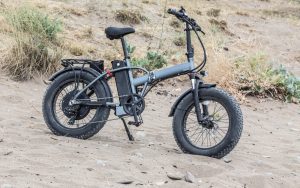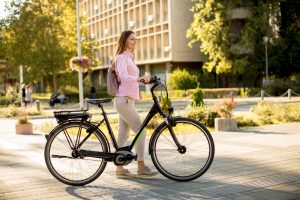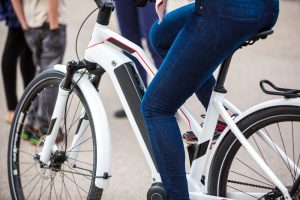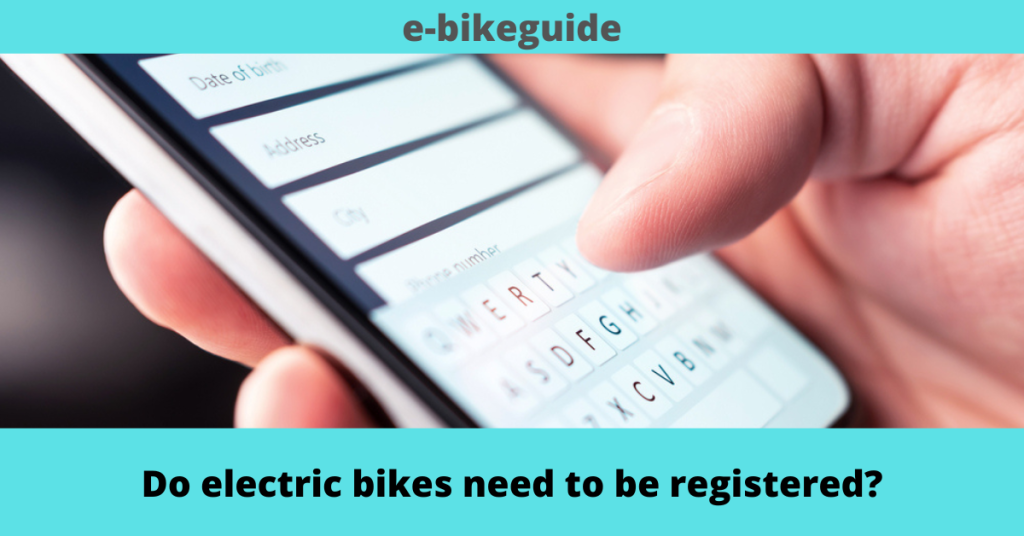
Certain types of electric bicycles are required by law to be registered. Do electric bikes need to be registered? The answer is yes, electric bikes need to be registered but it depends on the city that you are in. This is what you need to know. First, we need to determine if what you call an “e-bike” is actually a pedelec, S-pedelec, or e-bike under the law. Find out which kind of e-bikes need a license, how much power they can have, and whether or not they need insurance. If you plan on riding an S-pedelec or e-bike, you’ll need registration and insurance number plate, as well as a valid driver’s license. Pedelec riders, on the other hand, are not required to have a valid driver’s license. Where do these automobiles diverge from one another, exactly? The word “pedelec,” a combination of “pedal” and “electric cycle,” describes a bicycle powered by an electric motor that activates only when the user exerts a force on the pedals. This means that the motor aid is, in the strictest sense, merely a pedal aid.

Only a start assist that allows the pedelec to reach a speed of up to 6 km/h without pedaling is allowed on these bicycles. Up to 25 kilometers per hour, a pedelec’s engine may not provide more help. For legal reasons, a pedelec is equivalent to a regular bicycle if certain conditions are met. Because of this, you can ride your pedelec without worrying about obtaining a license or a helmet. Pedelecs can use the same bike lanes as regular bikes. To put it simply, an S-pedelec (short for “speed pedelec”) is a bicycle that travels at a much higher rate of speed than a standard pedelec. When pedaling with a motor, S-pedelecs may achieve speeds of up to 45 km/h. These rapid bicycles must be registered as motor vehicles because the law classifies them with mopeds and motorcycles. A valid driver’s license, proof of insurance, and operating permission are all required of the rider (in Germany, class AM or higher).

A helmet is also required, and S-pedelecs are restricted to paths designated for cyclists only if mopeds are also allowed (which will be indicated by signage). The legal age to operate an S-pedelec in Germany is either 15 or 16 years old, depending on the individual federal state. The majority of e-bikes on the market today are pedelecs, but the term “e-bike” is often used interchangeably with either of these terms.
Do electric bikes need to be registered, what is the difference between an e-bike and a normal bike, and how much can you legally ride? The engine of a pedelec only assists the rider while they are pedaling, unlike a genuine electric bike. An authentic “e-bike” is a bicycle that has a motor that can be activated by the rider’s Weight. While still a small fraction of Germany’s electric bicycle market, e-bikes are further subdivided into models with varying top speeds. Mopeds include electric bikes that can reach speeds of up to 20 or 25 kilometers per hour. For this reason, you’ll need either a certificate from a moped test or a valid driver’s license to operate one (in Germany class AM or B).

To ride one of these bicycles, you must be at least 15 years old. You must ride these bicycles on designated bike lanes exclusively. The minimum age to ride an electric bicycle that can reach speeds of up to 45 kilometers per hour is 16, and a valid driver’s license (class AM or B in Germany) is required. No bike lanes are safe for these rapid bicycles. For speeds up to 20 km/h, a helmet is recommended but not required. However, while traveling at speeds of 25 km/h or greater, a helmet is required. The same registration requirement that applies to mopeds also applies to all electric bikes. In addition to mandatory registration and limited speeds, pedelecs, S-pedelecs, and e-bikes are subject to strict limits on their motor power outputs; for example, a pedelec’s motor can produce no more than 250 watts of power. Power limits for S-pedelecs’ motors are significantly greater, at 4,000 watts.
Electrically assisted bicycles with top speeds of 25 kilometers per hour generate 500 watts of power, while those traveling 45 kilometers per hour generate 4,000 watts. The same insurance regulations that apply to mopeds and motorcycles also apply to legally recognized e-bikes, which are electric bicycles that may be ridden without pedaling. It also implies they need to display an insurance license plate. The same holds true for S-pedelecs, which can reach speeds of up to 45 km/h with pedal assistance. The use of a helmet and insurance is optional for pedelecs. This may be the case, but consumer advocacy groups still recommend having private liability insurance in place. In San Francisco, California, many people use electric bikes as a mode of transportation to work.

For a good cause, it’s become a citywide phenomenon. The typical individual may do their part to reduce their carbon footprint by purchasing and riding an electric bike due to its low price, high dependability, and low difficulty of use. Everything is looking up for California’s commuters now. But you may be asking if you need the U.S. Do electric bikes need to be registered? Find out more about them and their benefits here. Registration for your e-bike or electric bike. No license or registration is required to ride an electric bike on the street, and they can be ridden anywhere. To move around town without adding to the air pollution, electric bikes are readily available and should be considered a viable transportation option. People who don’t want to deal with car ownership, driver’s licenses, or state registration may consider purchasing one of these motorcycles. While not all EVs require registration, knowing which ones do might be difficult. Here’s a quick rundown of what kinds of cars need license plates.
Can You Ride an Electric Bike Like a Normal Bike?

There are too many inquiries concerning e-bikes from the general public. A frequent inquiry we get is whether or not an electric bike can be ridden in the same way as a traditional bicycle. Let’s see if we can figure this out. To put it briefly, yes. Most electric bicycles are ridden in the same way as conventional bicycles. When batteries die, riders can still use the bike like a regular bike. It is important to note, however, that the electric bike’s battery may increase its Weight. If you want to use only your legs to propel your e-bike, you may choose to remove the battery. The vast majority of cyclists use the motor for the pedal assist feature. However, when riding high-end electric bikes, you might feel motivated to crank out a few extra reps. Learning about cadence sensing and torque sensing will shed light on the phenomenon’s causes.

Torque sensors are electronic devices that utilize a strain gauge to a high degree of accuracy. Samples the pedal power a thousand times per second during the entire pedal stroke. In conclusion, the torque sensor determines how much electrical power is required from the motor by measuring the rider’s pedaling effort. On the other hand, cadence sensors function similarly to a switch. When you begin pedaling, the engine powers up, and it shuts off when you stop. Since a cadence pedal sensor can provide pedal assistance at a low cost, it is included on most entry-level electric bikes. Low-quality torque sensors, as found on most entry-level electric bikes, provide an inaccurate reading of pedaling effort. Consequently, the cyclist receives the entire power of the motor even while they are only pedaling softly.

When you ride with a high-quality torque sensor, however, it can adapt to your specific needs. If you cycle faster, for instance, you’ll collect more power. On the other hand, it will reduce its output if you gently pedal. In Toronto, one of the best places to check out electric bikes is at Amego Electric Vehicles. Torque sensors from industry leaders like Shimano and Bosch are standard on many of our electric bicycles. These bicycles will make you feel as though you should peddle harder than you feel comfortable doing. Thus, if you want to get in shape more quickly, investing in a high-quality electric bike means you can ride with more power and energy. Stop by our Toronto showroom to try out an electric bike of your choice. Free delivery inside Canada is provided on all orders over CAD$1900, and we also sell electric bikes online.
Can you use an electric bike without a battery?

Did you know that by 2025, the global market for electric bicycles would have expanded by 9.01% to $38.6 billion? E-bikes are equipped with a battery and a motor to provide riders with a helping hand when pedaling uphill. But then, what happens if the battery dies? When charging, is the e-bike still usable? Even if you forget to charge the battery, the electric bike’s engine will still work. However, it will be more difficult to peddle the electric bike without the battery, especially on hills or uneven terrain. Here we’ll discuss how long the battery of an e-bike lasts, what circumstances would call for going battery-less, and what you may expect to happen if you do go battery-less.

Arguments for Using an Electric Bike Without the Battery Electric bicycles simplify one’s life by providing an extra boost from a little motor. The incorporation of a battery guarantees that you can ride for long periods of time without becoming fatigued, so facilitating the development of your endurance. Sometimes, though, you’ll have to take the e-bike for a spin without the battery. Some of these situations are: When Physical Activity Is Necessary. The pedal-assist feature of an e-bike may discourage riders who are used to a high level of physical exertion while riding a conventional bike. If you were to take the battery off of the bike even sometimes, you could ride further without using any more energy, allowing you to get in more of a workout.

Battery Drain There will be instances when you need to get somewhere quickly but can’t because you forgot to charge the battery. If this happens, just take out the battery and get on on your day. Taking the battery off the bike makes it much more manageable. After charging a battery, it’s easy to forget to put it back in its slot. It sounds like you’ll have to make the ride without it. Limits on Weight In order to ride your bike anywhere that has weight restrictions, you may need to remove the battery. If you plan on using a chairlift, for instance, and you bring a battery that weighs more than the chairlift’s capacity, you may have trouble. If that’s the case, you need to get rid of the battery, so you don’t exceed legal weight restrictions. Taking Off on a Plane Due to safety concerns, passengers are not allowed to bring larger batteries onto planes. When batteries come into contact with metal objects, such as tools or other batteries, a short circuit may occur.
conclusion

Do electric bikes need to be registered? The popularity of electric motorcycles has skyrocketed in recent years. Deloitte forecasts 130 million sales of electric bicycles between 2020 and 2023. There are numerous explanations for their widespread appeal. As gas costs continue to rise, some individuals are opting to ride them instead of driving their cars. There is no need to worry about keeping fuel in them because they do not use fuel. Others wish to avoid the perspiration associated with riding a regular bicycle to work. Despite its usefulness, you may be wondering if electric bicycles require a battery at all times. Even the most powerful batteries eventually need to be replaced. Thankfully, you can still ride the bike even if the battery dies. What this means and why there may be times when you need to ride your bike without its battery will be covered further down.

The electric motor, battery, throttle, and other components give an electric bicycle a more complex design than a traditional bicycle. There are more moving parts, so it makes reasonable that consumers would be reluctant to risk damage by riding without a charge. However, rather than the bicycle being stressed, it will be your muscles. The electric bike can be ridden in the same way as a conventional bicycle. In any case, you won’t have to worry about being left behind if the batteries die. Keep in mind that the electric bicycle is heavier than a regular bicycle should you opt to ride it without electricity. That makes it extremely tough to bicycle up a hill. If you have a hefty bicycle, you may find it easier to push it instead of riding it.
